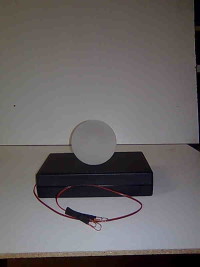BIO-Light [160325]

A plant controls the color of an RGB LED. The LED lightens a ball of milky glass or selenite.
All living organisms produce a tiny voltage on their surface. This voltage changes due to environmental influences and physiological processes. This effect is made visible and used to control the color of a RGB LED. Connected to a plant (you can also connect it to humans) it reacts on touching it, coming near to it, watering, sunlight, etc.
Without external influence the color changes every hour due to physiological influences.
Without external influence the color changes every hour due to physiological influences.




Discussie (2 opmerking(en))
bench0388 1 jaar geleden
It is not clear what SMD size of resistors and condensator to choose :
the list of components and the values specified in the circuit schema is not the same
I would like to print the PCB and assemble the resistors and condensators , what is the list and references of components ?
Thank you,
Benoit
J.F. Simon, Elektor 1 jaar geleden
The project on this Labs page is the early prototype of what became the "Bio-Light" published in January 2018. As you are talking about SMD resistors and PCB, I'm guessing you are referring to building the latest version of the project. On the webpages associated to the article (click here for English or here for French), you will find the list of components, as well as the Gerber files for the PCB. Most of them are 0805, with a few exceptions which are indicated. I would highly recommend that you use one of the popular PCB suppliers (such as JLCPCB or PCBWay; we are not related to them) to provide you the finished PCBs for a very affordable price, because home-etching a double-side PCB of this side is not trivial due to alignment issues. If you prefer to etch the PCB at home, be careful, the "PCB PDF" linked in the above pages has some issues, that most likely appeared when exporting from Gerber to PDF at the time of publication (sorry about that...). In that case, I'd recommend that you use a Gerber viewer program instead, and you export to PDF yourself. Best regards, JF Simon
Digit 7 jaar geleden
Il est dit dans l'article que vous n'êtes pas sûr de la provenance du signal. Celui-ci pourrait aussi provenir de l'environnement. Pourquoi ne pas évaluer le montage dans une cage Faraday ? Peut-être qu'une simple boîte métallique pourrait convenir pour ce test.
Merci.
Cordialement.
Dear Polli,
In the article you say (or it is said...) that you are not sure of the signal source. The signal may come from the environment and not from the plant. To be sure why don't you estimate this electronic project in a Faraday cage ? Perhaps a simple metallic tin should be suitable for this test ?
Thank you.
Regards
Christophe